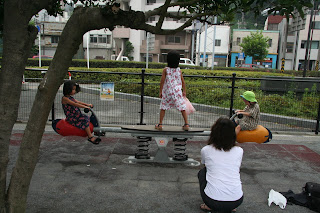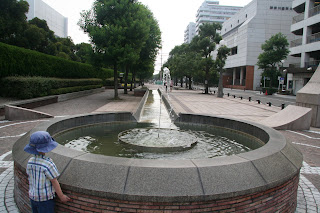This is about PCSed folks, not TDY, and especially not TDY dependents (spouses, children, etc.) the U. S. Naval Hospital Yokosuka is closest to Womble gate, and is a 'one stop shopping' type of place.
Emergency room, pharmacy, dental, laboratory, GPs, surgery, etc. For a complete list of what, and the phone numbers, go to the cfay page, click on links at the top, and towards the bottom of the list is
U.S. Navy Hospital.
The emergency room experience was kind of weird. We came through the side of the hospital near the bus stop that says EMERGENCY on it, and turned to our left, and went into a small 'box.' I was told I couldn't see them, but they could see me. Someone showed up with a clip-board, and we were then assigned a curtained-off area. From that point, it was just like any other emergency room experience, except it was fast.
The clip board person will want to know your SPOUSES social security number, or at least the last four digits. They'll want to know their 'command,' which I assume is PSNS. You are definitely a DoD civilian (which they list as being folks they care for, however, being a TDY spouse or dependent... I'm not sure which way they'll go with this). They might want your spouses work phone number. Have your health insurance card ready, as well.
Rear Admiral Kelly spoke to a group of us, and promised they'll help us out over here. He also said if they don't have the specialized equipment needed, they will send you off base. A friend had to do this, and they sent her with an interpreter. But it was a pretty unique service needed. Again, I really don't know how they'll handle the dependents of TDY.
When I was here TDY, I had a cyst rupture (I didn't know it at the time). I thought I was having an appendicitis attack, without the fever. I was memorizing the Japanese words for sick and pain and hospital. I figured I'd try to get on base first to the hospital, and go from there. Hey, when you need help, you need help. And that's when you're secretly glad the Japanese study so much!!!
A friend (spouse to a DoD Civilian PCSed here) just had surgery, and said she was impressed by the US Navy hospital. For another condition they couldn't treat here, she was sent home. They paid for car and hotel while she had tests done.
At USNH, military get preference. A retired military, now PSNS employee spouse and I had to wait a WHOLE DAY in the dental emergency room to be seen for a crown that popped off. When we arrived, they explained that they are low staff (people deployed to Iraq) and that they'd try to work her in. While we waited, we watched many children be escorted back to have their teeth looked at, or cleaned. One of the kids moms said that it is such a long wait to get to see a dentist, that she wasn't going to cancel! So, there are few cancellations, and therefore took so long to get in to be seen. They told her the root needed pulled.
Eventually my retired military/DoD Civ spouse flew home to Washington state to see her dentist and have him take care of this. He re-did the crown.
So, moral of this story is, get your dental work done at home!!! I come home each year on our own dime, and one of the things I have done is my dental. I teach a dentist English here, and I have no reason to believe that dentists aren't top notch here. But, I'm pretty picky and need to trust the person who sticks drills into my mouth. That niggling tooth ended up being a pain until I got home to take care of it.
Second moral of the story: Don't get sick! If you do, it is a modern country, and you'll be fine. Some places abroad ask that you pay up-front, and sort out the rest with your health insurance later (keep that receipt!). I had to pay like that in Canada (carry-you-down-the-mountain-ski-accident emergency room visit) and Australia (strep throat Doc-in-a-Box... Group Health and Blue Cross respectively), but I used to travel a lot.


















































